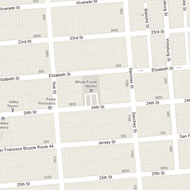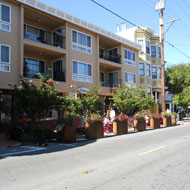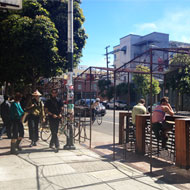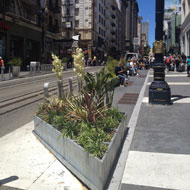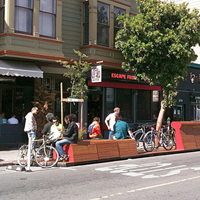
San Francisco, CA
Background
San Francisco’s streets and public rights-of-way make up fully 25% of the city’s land area – more space even than is found in all of the city’s parks. Many of the streets are excessively wide and contain large zones of wasted space, especially at intersections. San Francisco’s Pavement to Parks project temporarily reclaims these unused swathes, and quickly and inexpensively turns them into new public plazas and parks. During the temporary closure, the success of these plazas will be evaluated to understand what adjustments need to be made in the short term, and ultimately, whether the temporary closure should be a long-term community investment.
San Francisco’s Pavement to Parks projects are inspired by the recent success of similar projects in New York City, where plazas and seating areas have been created in excess roadway simply by painting or treating the asphalt, placing protective barriers along the periphery and installing moveable tables and chairs. Streets such as Broadway have been transformed into much more inviting and pedestrian-friendly spaces through New York’s efforts.
Each Pavement to Parks project is intended to be a public laboratory where the city can work with the community to test the potential of a selected location for permanent reclaiming as public open space. Materials and design interventions are meant to be temporary and easily moveable should design changes be desired during the trial run. Seating, landscaping and asphalt treatment are common features of all projects.
Locations for Pavement to Parks projects are selected based on the following criteria:
- Sizeable area of underutilized roadway.
- Lack of public space in the surrounding neighborhood.
- Preexisting community support for public space at the location.
- Potential to improve pedestrian and bicyclist safety via redesign.
- Surrounding uses that can attract people to the space.
- Identified community or business steward.
Pavement to Parks is a collaborative effort between the Mayor’s Office, the Department of Public Works, the Planning Department and the Municipal Transportation Agency. Each project requires partnerships for implementation. For example, the cost of the 22nd Street Parklet was paid for entirely through donations by San Francisco resident Mr. Jonathan Weiner and the three businesses fronting this Parklet.
Adopted from: Pavement to Parks
Lessons Learned
Potential Benefits:
- Provides flexible space, e.g., using moveable tables and chairs.
- Increases space for outdoor dining, bike parking and landscaping.
Potential Issues:
- Location selection criteria: Selection criteria must be met.
- Collaborative effort: Projects require funding, volunteers and partnerships for implementation.
Sources
Pavement to Parks (http://sfpavementtoparks.sfplanning.org/index.htm)
Photo Sources
MIG, Inc.

